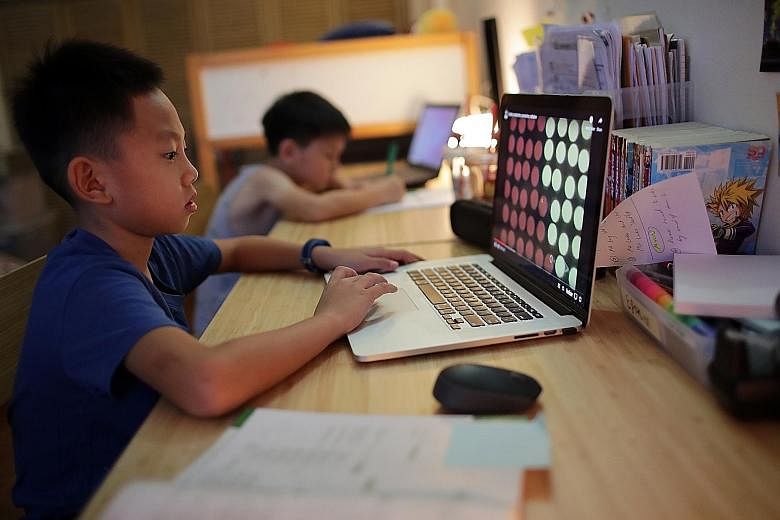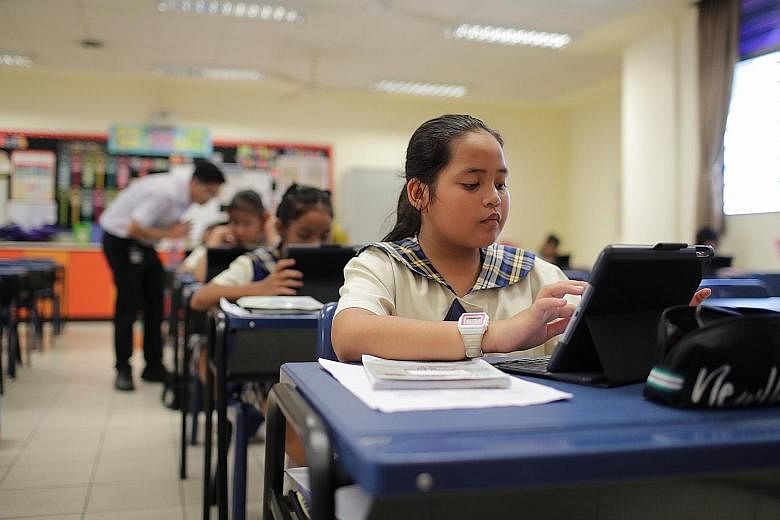Primary school pupils attended school virtually yesterday despite some teething issues, as the Ministry of Education (MOE) rolled out home-based learning to prepare families if the Covid-19 situation calls for more of it.
Some 200,000 primary school pupils followed different timetables set by schools, combining e-classes on the Singapore Student Learning Space - an online platform - and offline assignments.
Even physical education classes were carried out online - for example, pupils engaged in high-intensity interval exercises by following a YouTube video.
Housewife Joanna Tan, 40, said her Primary 1 daughter and Primary 5 son shared a laptop, taking turns for online lessons.
"The school gave each level a time slot to log in. In the late morning, the system kept hanging and my son couldn't upload his assignments," she said. Her children also could not access some slides as Web traffic was heavy.
But the teacher was quick to reply to parents' queries, she added.
Education Minister Ong Ye Kung said on Facebook yesterday: "Please bear with us as we iron out the tech glitches... There is a lot of adjustment to be done. Hence it is important to get this started, involving every student, for one day a week.
"It's not easy, and it's not perfect, but we are tapping our collective efforts to get this to work during such exceptional times."
Mrs Janeshtha Vaswani, 47, said her Primary 2 son used her personal laptop for home-based learning, and she could supervise him while working from home this week. "But next week, I need to be in the office, so it will be a bit challenging to do that. But we shall see," said the assistant manager at a medical school.
MOE announced last Friday that primary schools would conduct home-based learning on Wednesdays, secondary schools on Thursdays, and junior colleges and Millennia Institute on Fridays.
Home-based learning will last between four and six hours on those days, depending on students' levels.
Meanwhile, schools remain open for a small group of students whose families do not have alternative care support, or who lack resources such as devices and Internet access at home.
Mr Ong, who visited Sembawang Primary School yesterday, said about 20 children were there.
"A few were there because they did not have Wi-Fi at home, others had parents who had to work. Several of the children were ushered to computer labs to do some online learning. Others were in classrooms doing offline reading and assignments," he said.
Stamford Primary School principal Cassie Fan said its lower primary pupils logged on from 8am to 10am yesterday, while upper primary pupils had e-lessons from 10.30am to 12.30pm. Pupils spent another two hours or so completing worksheets and going through reading materials offline.
Ms Jastina Putri Marhajas was one of eight teachers at the school yesterday to help pupils who required support. There were 69 of them.
Madam Fan said: "The majority of these pupils' parents work in service sectors. Quite a number are daily wage workers."
Ms Jastina, 40, set up mathematics lessons on fractions for her Primary 4 and Primary 5 pupils who were at home, using video resources from MOE and supplementing them with questions of her own.
She also set up a video-conference call on Google Hangouts Meet for about 45 minutes so that pupils could ask her questions.
Housewife Grace Hobbs, 42, whose two sons are in Primary 1 and Primary 3, said: "There were some intermittent connecting issues but I'm not surprised, given that so many users are accessing the portal at the same time. It teaches the children to be more patient.
"Once they started the online lessons, they were very focused... The materials were quite engaging."
She added: "I need to plan a little better and set some ground rules, like trying different rooms, desks and devices, or not talking to each other during lessons."
Madam Kathleen Goy said her Primary 4 daughter enjoyed the day of lessons at home. "She gets to wake up later, she likes being at home... I'm quite surprised she was so disciplined," said the 39-year-old who works in marketing and events.
Despite some difficulties uploading an oral recording for a Chinese lesson, the rest of the online learning went smoothly, she said.
"We worked from different rooms, and once in a while, I checked in on her. She has done e-learning before so it's not entirely new," she added.


